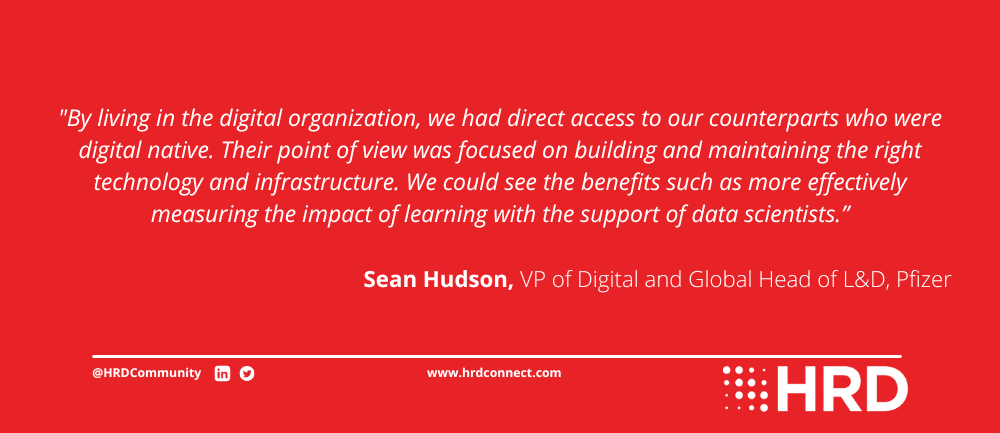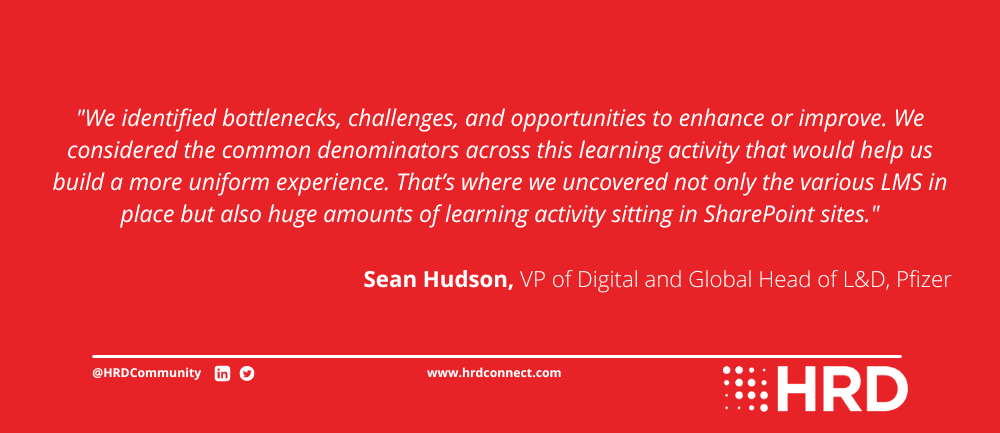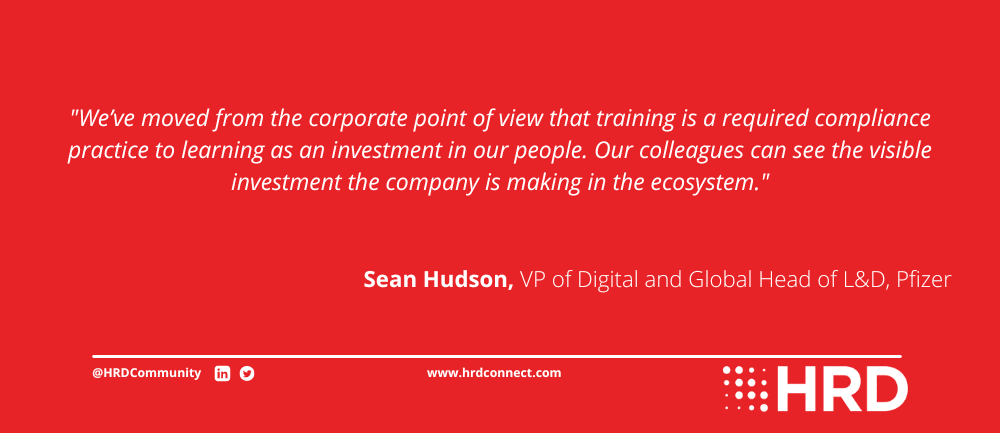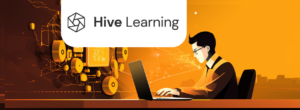-
Provided by

- Date published: Mar 13, 2023
- Categories
HR technology and L&D make up two of the top four investment priorities for HR leaders in 2023. Pfizer is unifying these two investment areas as it aims to better use technology to power its people’s learning experience. Alongside moving its L&D function to within its digital division, the pharmaceutical giant has undertaken the arduous task of centralizing four separate learning management systems (LMS) into one cohesive platform. This long-term transformation is underpinned by two core objectives:
- Be intentional about using digital technology to transform the learning experience
- Take advantage of advanced analytics to understand more about learners and customize the learning experience
By doing so, Pfizer aims to ensure the technology it uses to create and deliver learning experiences is contemporary, fit for purpose, and agile to evolve as technology adapts. In heavily regulated sectors such as pharmaceuticals, this approach to L&D balances mandatory training with faster and more engaging learning opportunities.
Sean Hudson, VP of Digital and Global Head of Learning and Development at Pfizer, takes us through this process, and how it has redefined both employee learning and the customer and patient experience.

Proliferated learning management systems: Complex and cumbersome
Prior to the centralization process, Pfizer’s LMS were outdated and complex. It relied on four parallel LMS that created confusion and wasted resources. It was ill-equipped to deal with a rapidly evolving technological landscape. “We were spending quite a bit of resource to maintain the many systems that we had. So, part of it was financial. To be wiser with our resources,” explains Hudson. “It was also limiting our ability to create the learning experiences that we wanted. Thirdly, it was creating unnecessary complexity and variability, and limiting standardization and uniformity.”
Pfizer strives to make its learning experiences consistent, engaging, and dynamic, regardless of the content. Its learning ecosystem was cumbersome, bulky, non-interactive, and uneven. A centralized LMS promised to deliver learning opportunities that employees would digest effectively. This viewpoint was supported by the L&D team’s early experience as a part of Pfizer’s digital division.
“By living in the digital organization, we had direct access to our counterparts who were digital native. Their point of view was focused on building and maintaining the right technology and infrastructure. We could see the benefits such as more effectively measuring the impact of learning with the support of data scientists.”
Sitting in the digital division gave Pfizer’s L&D team access to all the information and expertise it needed to imagine a different future for learning.

Creating a centralized LMS
Beginning a digital transformation requires buy-in at all levels. Support from the C-Suite can be particularly valuable. “In a typical situation, we would have had to go up the food chain and make business cases,” Hudson states. “But our CEO and CIO were the co-owners of the decision to make L&D a part of driving digital transformation across Pfizer.” Hudson and the L&D created a commonality between this transformation, and Pfizer’s broader ambition to apply its customer-facing principles of innovation and scientific progress to its workforce. With buy-in in place, Pfizer turned its attention to the transformation process itself.
Step 1: L&D Inventory
With four parallel LMS in place, Pfizer had a plethora of learning and training activities happening across the enterprise. The first step was understanding where this activity was occurring, who owned the activities, and who was responsible for creating or curating the learning content and experiences.
Step 2: Identifying bottlenecks
Having created a picture of what Hudson calls ‘The Landscape of Opportunity,’ attention turned to gathering a deeper understanding of the end-to-end processes and where they could be improved.
“We identified bottlenecks, challenges, and opportunities to enhance or improve. We considered the common denominators across this learning activity that would help us build a more uniform experience. That’s where we uncovered not only the various LMS in place but also huge amounts of learning activity sitting in SharePoint sites.
“It was such a complex system. So, one of the immediate questions was, ‘Is that necessary?’ No one could answer that question with a ‘Yes.’ Removing complexity became a common purpose. We had to create an ecosystem that supported it.”
Step 3: Understanding divisional needs
With approximately 83,000 employees worldwide, Pfizer’s L&D team was conscious of supporting requirements across its different divisions and geographies. “We never want to put ourselves in harm’s way with compliance, legal training, manufacturing, or standard operating procedures. Understanding the unique requirements for each function and division was a critical part of this task,” explains Hudson.
This approach gave Pfizer a firm grasp on ‘The Landscape of Opportunity,’ including what needed to be customized and for whom.
Step 4: Identifying the technology partner
Pfizer was then positioned to consider the correct technology partner to deliver its use case for a centralized LMS. Firstly, for regulatory compliance purposes, the new LMS needed a future-proof system of record that documents required training. “But we realized there’s more to it than just documenting the required training,” acknowledges Hudson. “If we’re going to power our future, we needed to encourage people to learn through curiosity.” Accordingly, Pfizer also added a learning experience platform into the requirements for its ecosystem.
“Now, as of the end of 2023, there’s a single destination where you can consume all your learning: Required learning, role-based learning, and desired learning. All in one place.”
Step 5: Building a team for LMS implementation
A dedicated team within Pfizer’s L&D division is responsible for its learning technology ecosystem. This team was at the forefront of the centralization process, from vendor selection to project management.
“We were attempting to achieve an enterprise-wide solution. So, we did not want it to be too narrowly defined. This team partnered with our creation center leads, to form the Learning Council. The Learning Council sought to find senior leaders with every function who had training as a priority.
“We convened them periodically throughout the year, not only to understand what they wanted or needed from this new set of solutions but also to sort of establish them as the governance organization around learning across the entire company. We balanced the right set of leadership and influencers with technical and functional expertise, including external partners. These partners ensured each team completed the step-by-step implementation process correctly, on time, and on budget.
Step 6: Reflect and learn
Having completed the centralization process, Hudson reflects on the core learnings that Pfizer’s L&D division will take on its path to power the L&D process with technology.
“Firstly, the critical importance of collaboration. Articulate the value proposition, not just in a singular way, but tailored to each collaborator and why they would choose to take part.
“Beyond collaboration, you’re going to hit snags. We’ve chosen to adopt agile as our way of working. We don’t strive for perfection and get stuck on our way there. Instead, we move quickly, establish MVPs to build feedback loops and mechanisms for fast learning, and if something is working, accelerate to expand and scale it. If something’s not working, diagnose it, fix it, and move forward.
“Lastly, don’t just assume that everything needs to be top-down. A lot of the learning comes from those who are executing. Elevate the voice of those who are driving the real work, and empower them horizontally, not hierarchically.”

The benefits of a centralized LMS
Rather than scouring multiple places for the correct information, opportunity, or learning experience, Pfizer now has a single source of truth. It has a single platform for quantitative and measurable information on learning processes. This enables L&D and People Experience leaders to better access actionable insights about their learners. Furthermore, it has elevated the importance of L&D across Pfizer.
“We’ve created a community of practice across the entire company. Now, rather than people thinking about just the learning and training that they’re responsible for their function and division, they have clear access to a huge range of learning opportunities across the organization.
“We’ve moved from the corporate point of view that training is a required compliance practice to learning as an investment in our people. Our colleagues can see the visible investment the company is making in the ecosystem.
“We’re supporting this mindset shift with initiatives like Focus Week. We invite colleagues to strip away meetings and use that time to make a learning objective or plan. To find something that they want to know more about or get better at. To feed their curiosity.”
Pfizer’s simplified LMS ecosystem is sprouting collaborative learning, where employees can learn from those they admire; share their experience with their peers; and even become a recognized super-user or subject-matter expert that their peers seek out.
Beyond its people, powering technology through L&D is also transitioning how Pfizer engages its customers and patients. Pfizer’s employees constantly require new skills. By encouraging employees to learn, and creating a more engaging learning experience, the L&D team is having a material business impact on customer experience.
Up next: Customized learning through ML and measurement
As Pfizer powers on with its drive for technology-enabled L&D, it is working on customizing the learning experience for its people through micro-segmentation and machine-learning technology. “The more we understand the uniqueness of our learners, the more we can understand what each individual needs,” says Hudson. “We’re going to use machine learning and thoughtful curation.”
More sophisticated measurement – enabled through a centralized and simplified LMS ecosystem – will play a huge part in this process.
“Can we accelerate the time to competency? To what extent did we delay or prevent erosion back to baseline? And more importantly, how can we correlate the impact of consumed learning to the impact on business performance? Our ability to quantitatively measure these areas will be the reason why we can secure more resources and support for greater future investment.”
Learning at Pfizer is becoming a choice, rather than a requirement, and one that employees are buying into. Streamlining four parallel LMS into one centralized system is a vital first step that will help it accelerate further technology-enabled improvements to its L&D offering.








